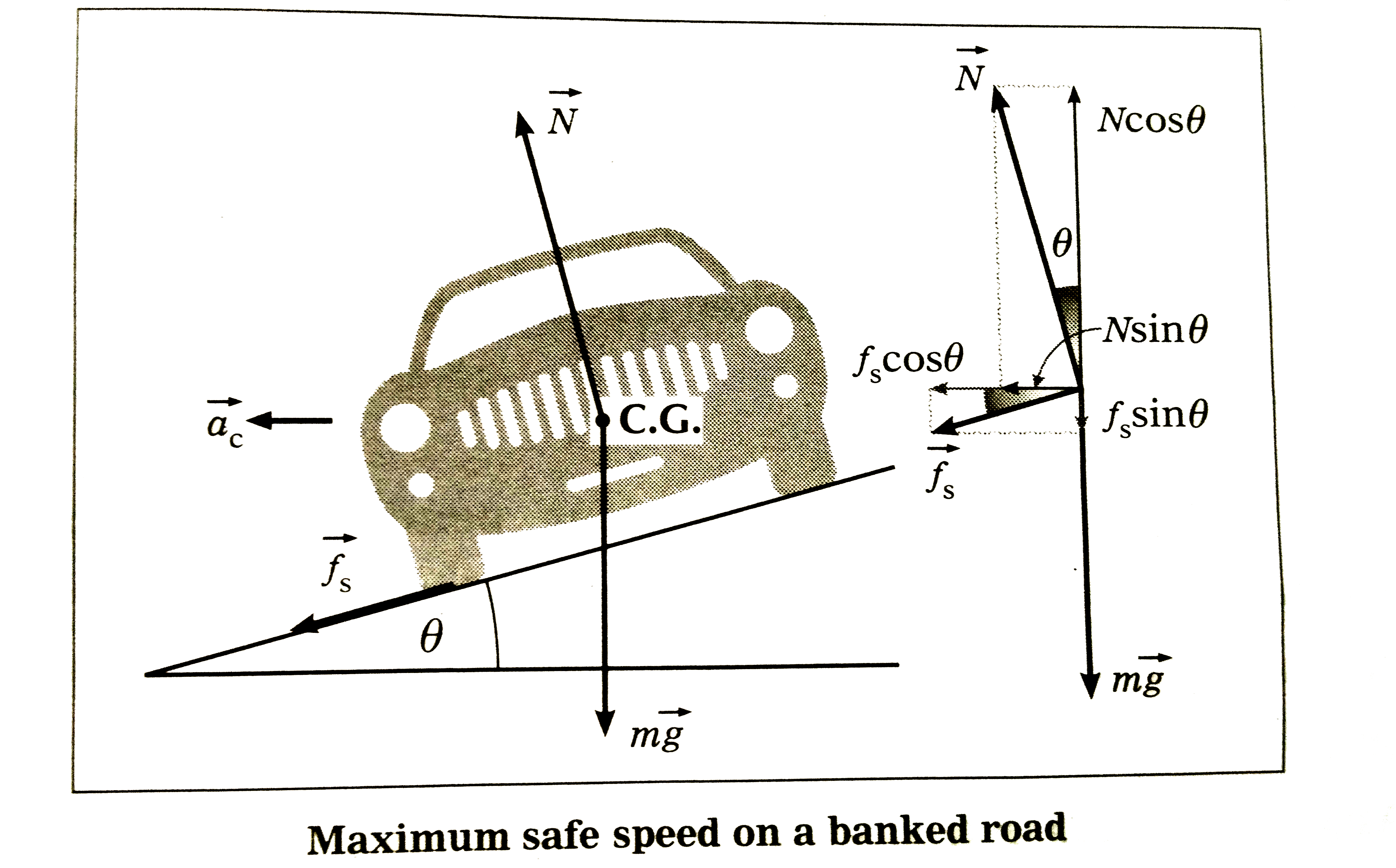The maximum speed with which a vehicle can be safely driven along curved road of radius r, banked at angle θ is
Consider a car taking a left turn along a road of radius r banked at an angle θ for a designed optimum speed v. Let m be the mass of the car. In general, the forces acting on the car are
(a) its weight −→mg , acting vertically down
(b) the normal reaction of the road →N, perpendicular to the road surface.
(c ) the frictional force →fs along the inclined surface of the road.

If μs is the coefficient of static friction between the tyres and raod, fs=μsN. If the car is driven fast enough, at a speed greater than the optimum speed v, it may skid up the incline so that →fs is down the incline.
Resolve →N and →fs into (i) cosθ vertically up and fssinθ vertically down (ii) Nsinθ and fscosθ horizontally towards the centre of the circular path. So long as the car takes the turn without skidding off, the horizontal components Nsinθ and fscosθ together provide the necessary centripetal force, and Ncosθ balances the sum mg+fssinθ. If vmax is the maximum safe speed of the car (without skidding),
(mv2max)=Nsinθ+fscosθ+μsNcosθ
=N(sinθ+μscosθ) ...(1)
and Ncosθ=mg+fssinθ=mg+μsNsinθ
∴mg=N(cosθ−μssinθ) ...(2)
Dividing Eq. (1) by Eq. (2),
mv2max/rmg=N(sinθ+cosθ)N(cosθ−μssinθ)
∴v2maxrg=sinθ+μscosθcosθ−μssinθ=tanθ+μs1−μstanθ
∴vmax=√rg(tanθ+μs)1−μtanθ ...(3)
At the optimum speed, the friction between the car tyres and the road surface is not called into play. Hence, by setting μs0 in Eq. (3), the optimum speed of a car on a banked circular road is
v=√rgtanθ ...(4)
Topper's Solved these Questions
- DERIVATIONS-IBook:NAVNEET PUBLICATION - MAHARASHTRA BOARDChapter:DERIVATIONS-IExercise:Gravitation
Explore 7 Videos
- DERIVATIONS-IBook:NAVNEET PUBLICATION - MAHARASHTRA BOARDChapter:DERIVATIONS-IExercise:Rotational Motion
Explore 13 Videos
- DEFINITIONSBook:NAVNEET PUBLICATION - MAHARASHTRA BOARDChapter:DEFINITIONSExercise:COMMUNICATION SYSTEMS
Explore 3 Videos
- DERIVATIONS-IIBook:NAVNEET PUBLICATION - MAHARASHTRA BOARDChapter:DERIVATIONS-IIExercise:Assignments
Explore 9 Videos
Similar Questions
Knowledge Check
For a curved track of radius R, banked at angle θ
AA vehicle moving with a speed v0=√Rgtanθ is able to negotiate the curve without calling friction into play at allBA vehicle moving with any speed v>v0 is ablce to negotiate the curve with calling friction into playCA vehicle is moving with any speed v<v0 must also have the force of friction into playDThe minimum value of the angle of banking for a vehicle parked on the banked road can stay there without slipping is given by θ=tan−1μs (μs=coefficient of static friction)The maximum speed with which a vehicle can negotiate a cuved road, which is banked at the angle θ=tan−1(0.24) is 54km/hr. IF the same road is flat and vehicle has to negotiate the curve with same maximum speed, the coefficient of friction between the road and tyres of the vehicle should be
A0.35B0.24C0.8D0.5The maximum speed of a car which can be safely driven along a curve of radius 10 m , If the coefficient of friction between the tyres and the road is 0.5, is (g=9.8m/s2)
A7m/sB14m/sC49m/sD21m/s
The maximum speed with which a vehicle can take safely circular turn on a horizontal flat rough road is (where symbols have their usual meanings)
View SolutionKeeping the banking angle same , to increase the maximum speed with which a vehicle can traveln on the curve road by 10% , the radius of curvature of the road has to be changed from 20 m to
View SolutionWhat will be the maximum speed of a car when it safely driven along a curved road of radius 100 m ? (μ=0.2)
View SolutionIf μs is the coefficient of static friction, the maximum speed Vmax with which a vehicle can negotiate an unbanked curved track having radius R and inclined at an angle θ with respect to horizontal plane is
View SolutionThe coefficient of friction between the tyres and the road is 0.25. The maximum speed with which a car can be driven round a curve of radius 40 m without skidding is (Take g=10ms−2)
View Solution

